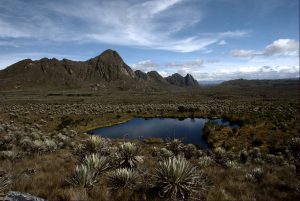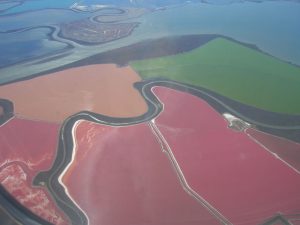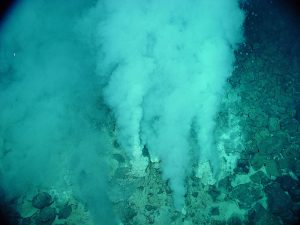Introducing the Life in Extreme Environments Collection
Written by Daniel Colman (Guest Editor, Montana State University), Ruth Blake (Guest Editor, Yale University) and Hanna Landenmark (Associate Editor, PLOS ONE).
We are delighted to introduce a Collection entitled Life in Extreme Environments, consisting of papers published in PLOS Biology and PLOS ONE. This interdisciplinary Collection helps us better understand the diversity of life on Earth in addition to the biological processes, geochemistry, and nutrient cycling taking place in many of the Earth’s most inhospitable environments, while also enabling us to make inferences about the potential for life beyond Earth. Microorganisms and other life in extreme environments are fundamental agents of geochemical and nutrient cycling in many of the most poorly understood environments on Earth. While we tend to think of these environments as lying at the boundaries of what life is capable of dealing with, many organisms are uniquely adapted to thrive in habitats at the extremes of temperatures, pressures, water availability, salinity, and other environmental characteristics. Indeed, these environments are certainly not “extreme” to these organisms, but represent their unique niches within ecosystems on Earth. The papers included in this Collection bring together research from different disciplines including the biosciences, geosciences, planetary sciences, and oceanography in order to shed light on this crucial topic.
We are immensely grateful to our Guest Editor team- Paola Di Donato (Università degli Studi di Napoli “Parthenope”), Jiasong Fang (Hawaii Pacific University), David Pearce (Northumbria University), Anna Metaxas (Dalhousie University), Henrik Sass (Cardiff University), Ruth Blake (Yale University), Daniel Colman (Montana State University), Karen Olsson-Francis (The Open University), Frank Reith (The University of Adelaide), Felipe Gómez (Centro de Astrobiología, Instituto Nacional de Técnica Aeronáutica)- for curating this Collection.
The importance of studying life in extreme environments
It is important to study life in extreme environments in order to establish life’s limits – both physical and geographic (e.g., the depth of life beneath the seafloor), as well as the capacity of life to withstand and adapt to change. Besides significantly expanding our understanding of the limits of familiar and extreme life on Earth, studies in extreme environments have also revised our understanding of the nature of the earliest life on our planet, as well as providing the possibility of discovering new industrially useful organisms or biological products. Moreover, if there is life on other planetary bodies in our solar system or elsewhere, they will almost certainly be living in what we consider “extreme environments” on Earth. Thus, understanding how life copes with what we consider extreme conditions can provide insight into how life may be able to persist on other planetary bodies, perhaps in the subsurface oceans of Saturn’s moon, Enceladus, or Jupiter’s moon, Europa.
Investigating extreme life
One of the most exciting aspects of researching extreme life is the exploration of the unknown and discovery of new things in unexpected places that expands our very way of thinking. Microbial life, in particular, has evolved to find a way to exist and even thrive pretty much everywhere we have looked so far. Moreover, contemporary research of extremophiles is happening at an exciting time when the lines between scientific fields have been increasingly blurred. The more we understand about how environments not only influence life in extreme environments, but how life also influences those environments, the more apparent it becomes that extreme ecosystems are dynamic systems with feedback between biological activities and ecosystem properties. These interdisciplinary perspectives certainly invigorate the study of extreme life.
Extremophile research is often interdisciplinary by nature, perhaps due to the close association with biological organisms and their ecosystems, and thus the need to consider environmental, geologic, ecological, physiological, and even evolutionary considerations when investigating how organisms are able to push the limits of life. The challenges can be considerable due to the need to integrate across many disciplines, which requires expertise in a number of areas (and requiring scientists across disciplines to productively engage one another). But the reward for conducting this type of research is that it can transform how we view the relationships between living organisms and their environments. These insights can be profound in terms of our understanding of organismal biology and broader evolutionary processes of adaptation.
Yet, by their very nature, extreme environments pose significant challenges for studying biological life within them. This can be due to their remote locations (e.g., deep sea environments, high altitude environments), or to specific dangers associated with studying them (e.g., geothermal fields or other volcanic environments). Indeed, the reason that these environments are considered “extreme” is because they are not amenable to humans spending much time within them. It takes serious dedication and preparation to execute scientific research under such conditions.
The future of extremophile research
The last 30-40 years have reshaped our understanding of life in extreme environments, but much remains to be discovered. As one example, we’re still only beginning to understand what types of microbial life can exist in extreme environments, let alone what the physiological adaptations of these organisms might be. One of the greatest questions in the study of life in extreme environments i whether life is present in other “extreme environments” of the Universe beyond our planet. While we cannot know whether answers to this question will be forthcoming in the near future, great strides are being made in pointing us in what may be the most likely directions.
The Life in Extreme Environments Collection
This Collection showcases a wide variety of research on how life, from microorganisms like bacteria, archaea, diatoms, and algae, through to macroorganisms like humans, survive and flourish in diverse extreme environments, ranging from hydrothermal vents and the deep ocean to permafrosts and hypersaline lakes, and from the high Andes to deep space. Many papers illustrate highly interdisciplinary approaches and collaborations, and provide important insights into the limits of life on Earth in truly extreme environments. As indicated above, extremophiles provide insight into far-ranging topics like the limits of life on Earth, biogeochemical cycling in extreme but globally important environments, insights into early life on Earth, and how organisms cope with conditions that push the boundaries of organismal physiology.
A critical component of extremophile research is understanding how extremophiles are distributed across environments in both contemporary settings as well as over geologic time. Serpentinizing environments are considered to be analogs for the environments where life originated on Earth (and that may also support life on other planetary bodies). The investigation of fully serpentinized rocks by Khilyas et al. document the endolithic (i.e., within-rock dwelling) microbial diversity within these unique environments, their associations with their mineral environments, and contrast their findings with those of active serpentinizing aqueous environments. Such studies examining the connection between extreme environments and their native microbiomes can be critical for understanding how organisms have and continue to interact with their environments over time. Another study in the Collection by Kiel and Peckmann provides new insights into the association of macrofauna with hydrothermal vents over the past ~550 million years. Their survey of dominant brachiopod and bivalve fossils over this period challenge the pre-existing hypotheses that these two groups competed for the same resources, with the latter group ultimately gaining prominence in the last ~100 million years. However, the authors show that the two groups likely inhabited different vent environments altogether, with brachiopods inhabiting hydrocarbon seeps and bivalves preferring sulfide-producing vents in association with their symbiotic sulfide oxidizing bacteria. To better understand the contemporary distributions of important marine microorganisms, Ferreira da Silva et al. documented how diatom communities are associated with macroalgae in the waters near the South Shetland Islands of Antarctica, revealing a potential role of the unique Antarctic climate in determining the biogeography of diatoms and their associated macroalgae. Indeed, the relationships among organisms may be critical for the habitation of extreme environments. In another investigation of cross-taxa associations in extreme environments, Gallet et al. evaluated the diversity of microbiota associated with enigmatic bioluminescent lantern fish species, and found that the latter might interact with its microbiome to inhabit the extreme environment of deep southern oceans. The data provide a better understanding of these important associations in key species involved in the ecosystem function of extreme deep sea environments.
Although extreme environments are often considered marginal habitats of mostly local influence, the functions of some extreme environments, and the organisms inhabiting them, can have particularly important implications for global biogeochemical cycling. For example, Nayak et al. document new insights into the functioning of one of the most important microbial enzymes involved in global carbon cycling, the methyl-coenzyme M reductase protein of methanogens, which catalyzes the key step of methanogenesis allowing the biological production of methane, which contributes to a significant portion of global methane production. In the authors’ investigation, they show how the protein is post-translationally modified by a previously unknown mechanism, and that this ‘tuning’ of methyl-coenzyme M reductase has profound impacts on the adaptation of methanogens to various environmental conditions. Anoxic peatlands are one such environment where methanogens play critical roles in biogeochemical cycling. These anoxic peatland environments are extreme environments that are important for global biogeochemical cycling, despite only occupying a small fraction of the total land space. Kluber et al. used an experimental warming approach to investigate how deep, anoxic peatland reserves would respond to fluctuating environmental conditions. The authors document that temperature is a key parameter that could drastically affect the decomposition of peatland nutrient stocks and their contribution to global biogeochemical cycling.
Key to the interaction between organisms and extreme environments are the adaptations that extreme environments impose upon organisms. The Collection features a number of investigations documenting the unique adaptations of microorganisms and macroorganisms to habitats ranging from hydrothermal vents to space at both the genomic and physiological levels. One of the most enigmatic discoveries of extreme environments over the past half century was the identification of entire ecosystems that dwell on or around hydrothermal vents at the ocean floor that are sustained by inorganic chemical synthesis from hydrothermal vent fluid chemicals. The paper within this Collection by Zhu et al. provides new evidence for the genetic mechanisms that allow the habitation of vent ecosystems by two distinct shrimp species that characteristically inhabit different thermal regions of vents. Using transcriptomic approaches, the authors identified new molecular mechanisms underlying how macrofauna can adapt to different hydrothermal niches within these extreme systems. Likewise, Díaz-Riaño et al. used transcriptomics to identify the mechanisms of ultraviolet radiation resistance (UVR) within high UVR bacterial strains that were isolated from high altitudes within the Colombian Andes. These new insights provide much needed resolution into the RNA-based regulatory mechanisms underlying UVR in organisms, which represents a fundamental knowledge-gap in our understanding of organismal adaptations to extreme altitude environments.
While life that persists continuously under extreme environments provide valuable information to understand the physiological limits of life, it is also critical to understand how life adapted to more ‘normal’ environments can withstand excursions to extreme environments over prolonged periods of time. One such example are oxygen minimum zones that occur in deep oceans where oxygen levels have been depleted to levels thought to not be able to support higher life, in what is termed ‘hypoxic conditions’. Nevertheless, some higher organisms are capable of living in such environments, although their adaptations to this lifestyle are not currently clear. One such species is the bluntnose sixgill shark that can tolerate very low levels of oxygen. Using an array of biologging techniques that allowed them to monitor the physiological and behavioral activities of these sharks, Coffey et al. provide evidence for their migratory behavior and long periods of exposure to hypoxic conditions in the deep sea. In addition to elucidating how sixgill sharks cope with extreme deep sea conditions, the new ecophysiological logging techniques provide a new platform for future studies of organisms adapted to the extremes of deep oceans. Among the possible excursions of life to extreme environments, none are potentially more problematic than the travel of humans to space. A common physiological effect of space transit is the bone mineral density (BMD) loss that is experienced by astronauts. In a paper within the Collection, Axpe et al., performed a modeling analysis based on BMD loss by previous astronauts involved in long-term missions in order to evaluate the potential for these harmful effects on trips that might become targets for longer manned missions to Mars or elsewhere. The study thus provides critical new data to inform these important missions.
As exemplified by the papers within this Collection, unique adaptations allow life to persist in extreme environments. These adaptations can also be useful in biotechnological applications, as several other papers in the Collection demonstrate. Halophiles that inhabit extremely saline environments have long been a source for bioprospecting due to their unique adaptations that allow them to maintain osmotic balance within environments that most types of life could not survive in. Notably, halophiles often concentrate unique biomolecules in order to overcome the abiotic stress of hypersaline environments. In their manuscript, Abdollahnia et al. explore the previously little-investigated ability of halophiles to concentrate nanoparticles, finding evidence for the unique ability to concentrate metal nanoparticles within archaeal and bacterial species. Importantly, these organisms could represent a potential environmentally-friendly means of synthesizing unique metal nanoparticles. Thus, the identification of new bio-resources is an area of ongoing and intense interest in the investigation of extreme life.
As is evident by the diverse range of topics, organisms, and environments within the papers of this Collection, the investigation of extreme life incorporates numerous fields of study and a wealth of methods to understand the limits to life on Earth. We’ll be adding new papers to the Collection as they are published, so please do keep checking back.
About the Guest Editors
Ruth Blake
 Ruth Blake is a Professor in the departments of Geology & Geophysics and Environmental Engineering, and in the School of Forestry & Environmental Studies at Yale University. Dr. Blake’s areas of expertise include marine biogeochemistry, stable isotope geochemistry and geomicrobiology. Her recent work focuses on developing new stable isotope tools, geochemical proxies and biomarkers to study marine/microbial phosphorus cycling and evolution of the phosphorus cycle from pre-biotic to recent.
Ruth Blake is a Professor in the departments of Geology & Geophysics and Environmental Engineering, and in the School of Forestry & Environmental Studies at Yale University. Dr. Blake’s areas of expertise include marine biogeochemistry, stable isotope geochemistry and geomicrobiology. Her recent work focuses on developing new stable isotope tools, geochemical proxies and biomarkers to study marine/microbial phosphorus cycling and evolution of the phosphorus cycle from pre-biotic to recent.
Dr. Blake is engaged in a range of studies on co- evolution of earth and life and the impacts of both on biogeochemical processes occurring in the oceans, deep-sea sediments, seafloor hydrothermal systems and the sub-seafloor deep biosphere. Dr. Blake has participated in several ocean exploration/ research expeditions including cruises to: FeMO observatory at Loihi undersea volcano, 9°N EPR, Orca Basin in the Gulf of Mexico and North Pond in the mid-Atlantic. She has also served as shipboard scientist on Ocean Drilling Program and R/V Atlantis /DSV ALVIN platforms. Ruth Blake graduated from the University of Michigan in 1998 with a PhD in geochemistry.
Daniel Colman
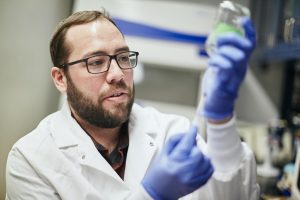 Dan is currently an assistant research professor at Montana State University and is an environmental microbiologist with primary research interests in broadly understanding how microbial populations interact with one another and with their environments. To investigate these broad topics, he uses a suite of interdisciplinary techniques at the intersection of environmental microbiology, biogeochemistry, geomicrobiology, microbial physiology, geochemistry, hydrology, and microbial evolution.
Dan is currently an assistant research professor at Montana State University and is an environmental microbiologist with primary research interests in broadly understanding how microbial populations interact with one another and with their environments. To investigate these broad topics, he uses a suite of interdisciplinary techniques at the intersection of environmental microbiology, biogeochemistry, geomicrobiology, microbial physiology, geochemistry, hydrology, and microbial evolution.
In particular, his work leverages environmental genomics methods coupled to in situ and laboratory experiments along with geochemical insights from hydrological and geochemical analyses to understand 1) how and why environments structure micobial communities, 2) how microbial communities shape their environments, and 3) how environments and microbial populations have co- evolved through time. In particular, he has largely focused on evaluating these questions in extreme environments, and especially hydrothermal systems, which represent an excellent platform to deconvolute microbial-environment relationships across substantial environmental gradients.
Paola Di Donato
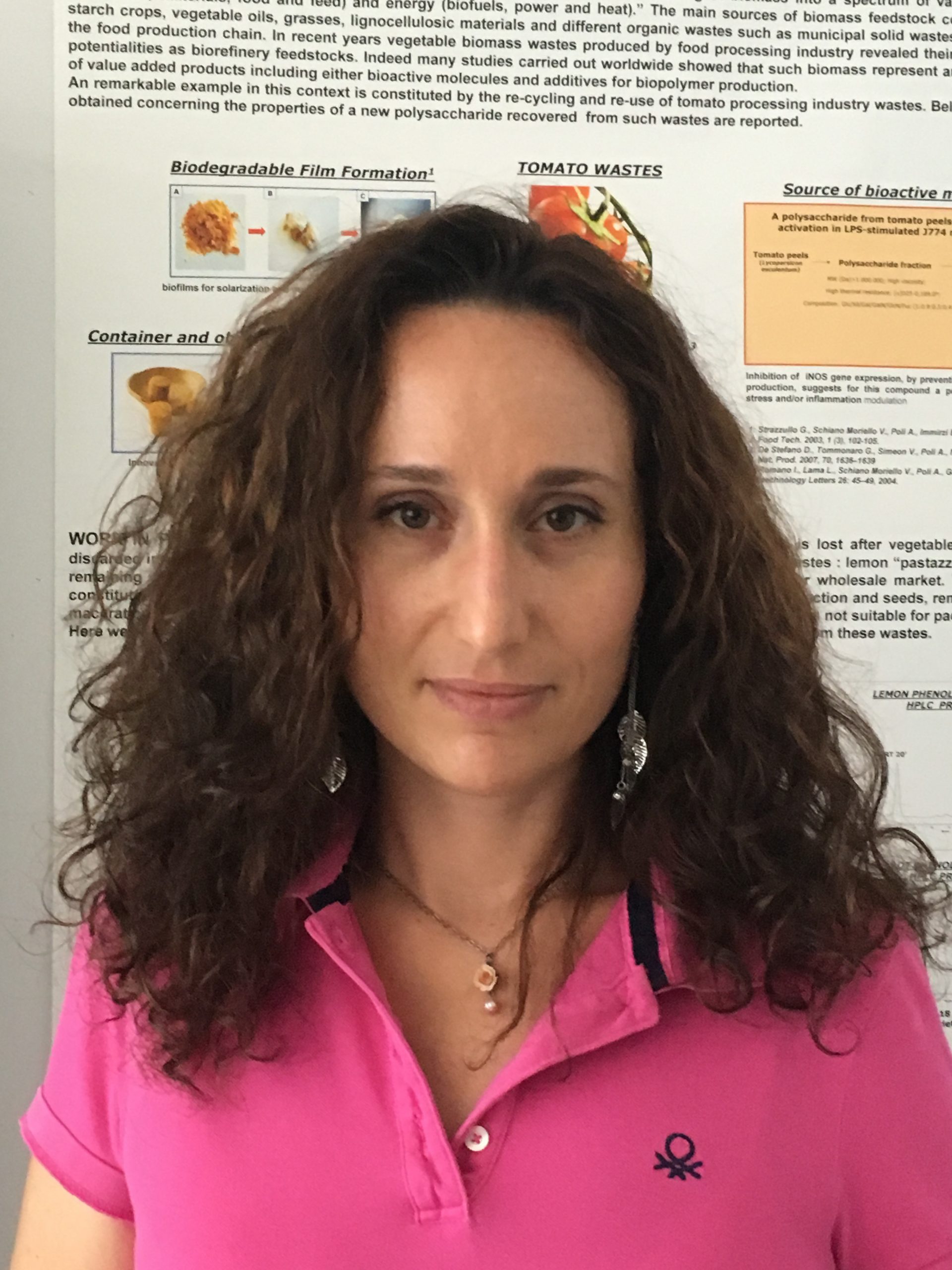 Graduated in Chemistry, Paola received her PhD in 2002 and since 2008 she is a Researcher in Biochemistry at the Department of Science and Technology of University of Naples “Parthenope”; in 2016 she has been appointed as the Dean’s delegate to managing the Institutional Repository of the University “Parthenope”.
Graduated in Chemistry, Paola received her PhD in 2002 and since 2008 she is a Researcher in Biochemistry at the Department of Science and Technology of University of Naples “Parthenope”; in 2016 she has been appointed as the Dean’s delegate to managing the Institutional Repository of the University “Parthenope”.
Her research interests are the valorisation of waste vegetable biomass and the study of extremophilic bacteria. With regard to the first topic, her research focuses on the recovery of value added chemicals (polysaccharides and polyphenols) and the production of energy (bioethanol) from wastes of vegetables food industry and of dedicated crops (giant reed, cardoon). With regard to the study of extremophilic bacteria, her research activity is aimed at studying the biotechnologically useful biomolecules (enzymes and exopolysaccharides) produced by these bacteria; in the last seven years, particular attention has been paid to the study of extremophiles in relation to Astrobiology, the multidisciplinary approach to the study of origin and evolution of life on Earth and in the Universe.
Felipe Gómez
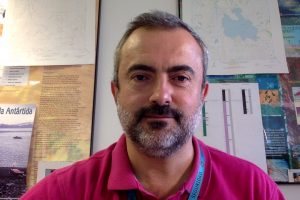 Dr. Felipe Gómez is a senior staff scientist at the CAB. His research work focuses on the study of extreme environments, limits of life and, by extrapolation, development of habitability potential in adverse environments. He participates in Mars exploration space missions to search for traces of life and study the habitability potential of the red planet. He is currently part of the scientific team (Co-Investigator) of the Rover Environmental Monitoring Station (REMS) instrument aboard the NASA Curiosity-MSL rover that is studying the surface of Mars at this time. Dr. Felipe Gómez is Co-I of MEDA instrument that will be onboard Mars2020 NASA mission to Mars.
Dr. Felipe Gómez is a senior staff scientist at the CAB. His research work focuses on the study of extreme environments, limits of life and, by extrapolation, development of habitability potential in adverse environments. He participates in Mars exploration space missions to search for traces of life and study the habitability potential of the red planet. He is currently part of the scientific team (Co-Investigator) of the Rover Environmental Monitoring Station (REMS) instrument aboard the NASA Curiosity-MSL rover that is studying the surface of Mars at this time. Dr. Felipe Gómez is Co-I of MEDA instrument that will be onboard Mars2020 NASA mission to Mars.
He has been part of the scientific team of several campaigns of astrobiological interest in studying different extreme environments. The project M.A.R.T.E. (Mars Analogue Research and Technology Development) began in 2003 and extended until 2006. Its principal investigator was Dr. Carol Stocker of NASA Ames Research Center. This project was funded by NASA within NASA’s ASTEP program for the development of technology for future space missions. This project was developed with the collaboration of several institutions in the United States and CAB. It consisted in the study of the subterranean environment of the zone of origin of the Tinto River (Huelva) where several perforations were made (160 m deeper) until reaching the anoxic zone isolated from the surface. The ultimate goal of the project was the design and development of an automatic platform for drilling without direct human intervention (automatic drilling) on the surface of Mars. This project was the beginning of research into the development of automatic drilling instruments for this purpose. It was developed in three phases: first and second year with non-automatic perforations and “in situ” study of the samples that were obtained in real time. In the third year, the automatic platform was implemented.
Jiasong Fang
 Jiasong Fang is a professor in the College of Natural and Computational Sciences of Hawaii Pacific University, Distinguished Chair Professor in the College of Marine Sciences of Shanghai Ocean University, and Director of the Shanghai Engineering Research Center of Hadal Science and Technology. Dr. Fang received his Ph.D. in oceanography from Texas A&M University and did his postdoctoral training at the Department of Microbiology of Miami University.
Jiasong Fang is a professor in the College of Natural and Computational Sciences of Hawaii Pacific University, Distinguished Chair Professor in the College of Marine Sciences of Shanghai Ocean University, and Director of the Shanghai Engineering Research Center of Hadal Science and Technology. Dr. Fang received his Ph.D. in oceanography from Texas A&M University and did his postdoctoral training at the Department of Microbiology of Miami University.
His scientific interests are primarily in the areas of high-pressure microbiology and biogeochemistry, focusing on piezophilic microorganisms and their role in mediating biogeochemical cycles in the deep ocean and the deep biosphere. He has co-authored 100 scientific publications.
Anna Metaxas
 Dr. Anna Metaxas is a Professor in Oceanography at Dalhousie University. She received a B.Sc. in Biology from McGill University in 1986, a MSc in Oceanography from the University of British Columbia in 1989 and a PhD from Dalhousie University in 1994. She was a Postdoctoral Fellow at Harbor Branch Oceanographic Institution from 1995 to 1997, and a Postdoctoral Scholar at Woods Hole Oceanographic Institution from 1997 to 1999.
Dr. Anna Metaxas is a Professor in Oceanography at Dalhousie University. She received a B.Sc. in Biology from McGill University in 1986, a MSc in Oceanography from the University of British Columbia in 1989 and a PhD from Dalhousie University in 1994. She was a Postdoctoral Fellow at Harbor Branch Oceanographic Institution from 1995 to 1997, and a Postdoctoral Scholar at Woods Hole Oceanographic Institution from 1997 to 1999.
Her research focuses on the factors that regulate populations of benthic marine invertebrates, particularly early in their life history. She uses a combination of approaches, such as field sampling, laboratory experiments and mathematical modelling, to study organisms of ecological and economic importance, including invasive species. She has worked in a variety of habitats from shallow rocky subtidal regions to the deep-sea, including hydrothermal vents and deep- water corals, in temperate and tropical regions of the world. Her research has implications for marine conservation, such as the establishment and success of conservation areas for benthic populations.
Karen Olsson-Francis
 Dr. Karen Olsson-Francis is a Senior Lecturer at the Open University, in the United Kingdom. Her research focuses on understanding the role that microorganisms play in biogeochemical cycling in extreme environments. She is interested in this from a diversity and functional prospective. In particular, she has focused on studying terrestrial analogue sites and utilizing this information to understand how, and where, potential evidence of life can be found elsewhere in the Solar System.
Dr. Karen Olsson-Francis is a Senior Lecturer at the Open University, in the United Kingdom. Her research focuses on understanding the role that microorganisms play in biogeochemical cycling in extreme environments. She is interested in this from a diversity and functional prospective. In particular, she has focused on studying terrestrial analogue sites and utilizing this information to understand how, and where, potential evidence of life can be found elsewhere in the Solar System.
David Pearce
 The underlying theme of David Pearce’s research is to use microbiology (and in particular novel molecular techniques applied to microbial ecology, microbial biodiversity and activity, environmental genomics, biogeochemical cycling and model extremophiles) to understand Polar ecosystem function and the potential for shifts in biogeochemical activity that may result from environmental change. He has taken the lead in the development of new frontiers of research in metagenomics, chemosynthetic communities, sediment sequestration of carbon and subglacial lake environments and have initiated new interdisciplinary approaches on the aerial environment (with chemists), ice nucleation activity (with physicists) and in the biogeochemistry of ice (with glaciologists).
The underlying theme of David Pearce’s research is to use microbiology (and in particular novel molecular techniques applied to microbial ecology, microbial biodiversity and activity, environmental genomics, biogeochemical cycling and model extremophiles) to understand Polar ecosystem function and the potential for shifts in biogeochemical activity that may result from environmental change. He has taken the lead in the development of new frontiers of research in metagenomics, chemosynthetic communities, sediment sequestration of carbon and subglacial lake environments and have initiated new interdisciplinary approaches on the aerial environment (with chemists), ice nucleation activity (with physicists) and in the biogeochemistry of ice (with glaciologists).
Frank Reith
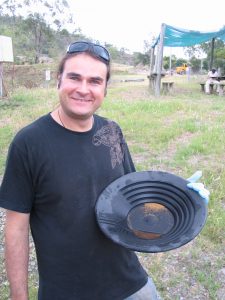 Frank Reith is an Associate Professor in geomicrobiology at the School of Biological Sciences at University of Adelaide and CSIRO Land and Water, where he heads the Microbes and Heavy Metal Research Group. He holds a PhD in Earth Sciences from the Australian National University. He is interested in microbial processes that affect metal cycling and the formation of new minerals. In turn, he also studies how microbes are affected by elevated concentrations of heavy metals in extreme environments. His particular interests lie in the biomediated cycling of noble/heavy metals, e.g., gold, silver, platinum, uranium, osmium and iridium.
Frank Reith is an Associate Professor in geomicrobiology at the School of Biological Sciences at University of Adelaide and CSIRO Land and Water, where he heads the Microbes and Heavy Metal Research Group. He holds a PhD in Earth Sciences from the Australian National University. He is interested in microbial processes that affect metal cycling and the formation of new minerals. In turn, he also studies how microbes are affected by elevated concentrations of heavy metals in extreme environments. His particular interests lie in the biomediated cycling of noble/heavy metals, e.g., gold, silver, platinum, uranium, osmium and iridium.
An important aim of the fundamental processes understanding created by his research is to use it to develop tools for industry, e.g., biosensors and bioindicators for mineral exploration, as well as biotechnological methods for mineral processing and resource recovery from electronic waste. Thereby, his approach is highly multidisciplinary and covers field expeditions to remote corners of the Earth, synchrotron research, meta-genomic and proteomic approaches as well as statistical-, geochemical- and reactive transport modelling.
We were very saddened to hear of Frank’s passing before this Collection published. We are immensely grateful for his contributions to PLOS and to his field of research, as well as for his enthusiasm and kindness. Our thoughts go out to his family and friends.
Henrik Sass
 Dr. Henrik Sass is senior lecturer in Geomicrobiology at the School of Earth and Ocean Sciences of Cardiff University. He received his PhD from the University of Oldenburg (Germany).
Dr. Henrik Sass is senior lecturer in Geomicrobiology at the School of Earth and Ocean Sciences of Cardiff University. He received his PhD from the University of Oldenburg (Germany).
Henrik is a biogeochemist, geomicrobiologist and microbial physiologist with a special interest in anaerobic processes and the prokaryotes involved, such as the strictly anaerobic sulphate reducers and methanogens. He has been working on anaerobic metabolism and described new metabolic pathways in methanogens. One main topic of his research is life in the extreme environments, particularly life in the deep biosphere and in deep-sea anoxic brine lakes. These studies aim to reveal how anaerobes adapt to their particular ecological niches (e.g. oxygen tolerance of sulphate reducers). His work utilizes a range of different approaches including in situ activity measurements and the estimation of viable population sizes, but also culture-based laboratory experiments. Another aspect of his work has been the use of biomarkers, including dipicolinic acid for the detection of endospores in environmental samples.



